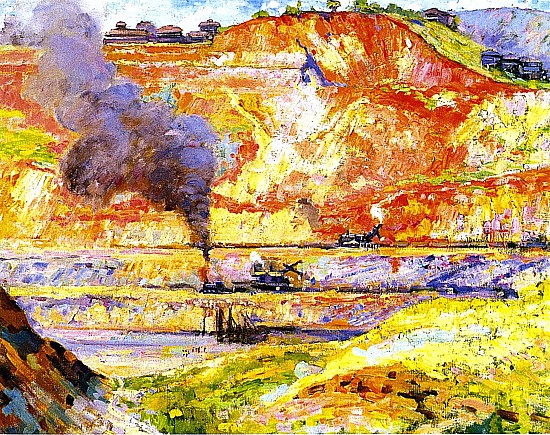 |
| Panama Canal, Alson Skinner Clark |
Yesterday, April 28, 2016, my wife and I passed through the Panama Canal aboard the MS Island Princess. The journey took some ten hours and covers about 48 miles as seen from our balcony on the Promenade Deck (below). It's a trip I've been planning for about ten years now, though it's been well down on my "bucket list" until recently. However, as I've checked off one "must-see" venue after another around the world, the canal has been steadily moving up the list. Then when my wife let it be known she did not wish to spend another vacation sitting in hotel rooms while I traipsed through a half-dozen major art museums, I suggested, a two-week cruise from Ft. Lauderdale to Los Angeles through the canal. She likes long, nothing-to-do-but-eat-and-relax cruises so, Panama it was.
 |
| Princess Cruise Line's Island Princess. Okay, so it's not the most stunningly beautiful ship afloat, but it's better than a rowboat. Launched in 2003, it was designed specifically for canal transit. |
When one thinks of art, very likely some stunning, early 20th-century engineering marvel like this probably does not come to mind. Except for the Eiffel tower perhaps, most engineering marvels (especially from that period) are very often not particularly lovely--not that such beauty is as absolute necessity in terms of art content. It does help somewhat, though. As with most such works of man, the element of beauty depends entirely on how you look at them--your point of view--and not just the artist's viewing angle, location, and color selection, but also the viewer's frame of mind. The esthete would note that the Panama Canal is a far cry from the Taj Mahal, while the aforementioned Mr. Eiffel might cry, "WOW! What a gorgeous ditch."
Our friend Mr. Eiffel might also lament the fact that his own countrymen had been the first to attempt such a ditch--and failed miserably. Fresh off their success in digging the Suez Canal, the French moved on to bigger and better things, turning the first spade of Panamanian dirt in 1881. It quickly became apparent that a ditch across a desert was a far cry from the engineering trials and tribulations inherent in digging one's way (at sea level, no less) across the Central American Continental Divide (the Culebra Cut, top). As if that weren't challenge enough, then there were the damned mosquitoes. The worker mortality rate for Yellow Fever (and Malaria) was astounding--over two-hundred a month at one point. Worse still, the French didn't even know what was causing this devastating health problem. The French effort went bankrupt in 1889 after reportedly spending $287,000,000 and costing an estimated 22,000 lives to disease and accidents. It also wiped out the life's savings of roughly 800,000 French investors. The French asking price for a buyout was $100-million. Teddy Roosevelt negotiated them down to $40-million. A little "gunboat diplomacy" and another $10-million managed to free Panama from an uncooperative Colombia.
 |
| The canal project as seen by the French, 1881. |
Our friend Mr. Eiffel might also lament the fact that his own countrymen had been the first to attempt such a ditch--and failed miserably. Fresh off their success in digging the Suez Canal, the French moved on to bigger and better things, turning the first spade of Panamanian dirt in 1881. It quickly became apparent that a ditch across a desert was a far cry from the engineering trials and tribulations inherent in digging one's way (at sea level, no less) across the Central American Continental Divide (the Culebra Cut, top). As if that weren't challenge enough, then there were the damned mosquitoes. The worker mortality rate for Yellow Fever (and Malaria) was astounding--over two-hundred a month at one point. Worse still, the French didn't even know what was causing this devastating health problem. The French effort went bankrupt in 1889 after reportedly spending $287,000,000 and costing an estimated 22,000 lives to disease and accidents. It also wiped out the life's savings of roughly 800,000 French investors. The French asking price for a buyout was $100-million. Teddy Roosevelt negotiated them down to $40-million. A little "gunboat diplomacy" and another $10-million managed to free Panama from an uncooperative Colombia.
 |
| Present day watercolors by New Orleans artist, Al Sprague. |
 |
| The shipping revolution that antiquated a canal. |


Jim, Thank you for using the artwork of my father, Al Sprague in your blog about the Panama Canal. The pieces you highlighted in your blog are from his very early pieces on the canal dating back to the 70s. Born and raised Panama, my father still paints Panama and the Canal and was honored to be commissioned to paint several paintings of the recent construction of the new locks.
ReplyDeleteFor additional information on him and his work you can visit his website located at http://www.panamaart.com.
Kassie--
ReplyDeleteMy pleasure, your father is an exceptional artist allowing us an opportunity to look back as well as looking forward, a bridge between past, present, and future. Thanks for reading and writing.